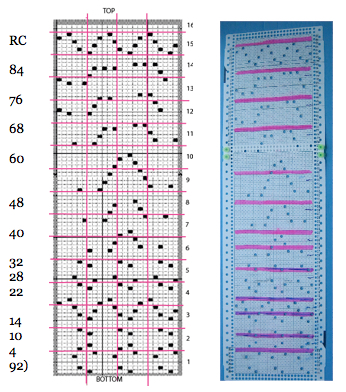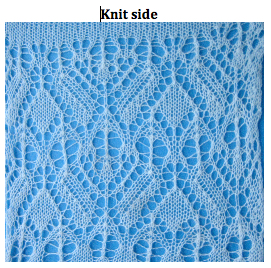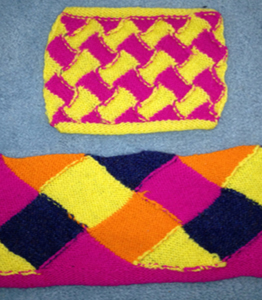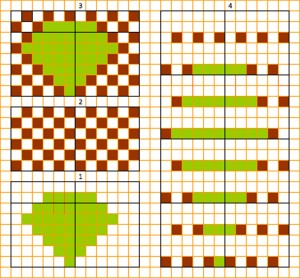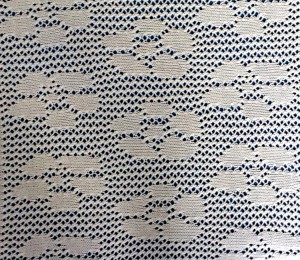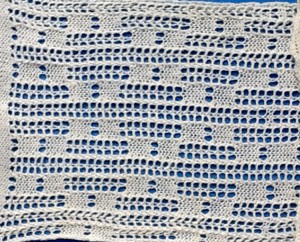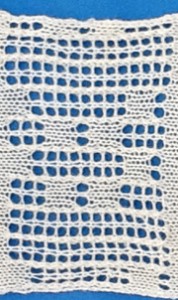My new production line of lace scarves, of varying fiber content, after pressing. There is an average of 10 lace carriage passes for every one row knit. Though a bit daunting for production, I am considering knitting some shawls in the same pattern and am in the process of exploring repeats for shawl borders.
Category: Lace
Entrelacs
Entrelacs abound in knitting at the moment. In thinking about perhaps composing my thoughts for a post on the subject, I searched online and found some very good sources on this subject. One is found at howtoknitasweater.com. The author, Cheryl Brunette also shares an article on lace . Here are 2 of my teaching samples, executed on 4.5 mm machine
front view
a rearview with ends woven in
Lace punchcards_use on the Brother 260 Bulky
There are a number of ways to “play with” this technique, transfer lace on these machines becomes a hand technique aided by needle selection made by the card reader, based on punched holes mylar markings.
Method 1: single carriage using published cards that are for lace carriages that transfer only (Brother, Knitking, Toyota, Studio/Knitmaster fashion lace started on the appropriate row ).
1. Lock card on the first row as would be done on a standard machine.
2. KH carriage starts out on the Left side with end needle selection canceled.
3. Remove yarn from the feeder, store on left. Deactivate the row counter (flip automatic tripper back ).
4. First selection row is made left to right. Transfers can then be made by hand in direction of arrows, moving stitches on the selected needles to their left, away from the carriage. All needles must be returned to the B position.
5. Push in both part (slip) buttons.
One thing to keep in mind: when the KH carriage is set to slip, it is the selected needles that actually knit stitches. If the carriage moves across those same needles with no yarn in the feeder, selected needles will drop their corresponding stitches.
6. Set card to advance “normally”, move the carriage to the left.
7. Continue to make transfers that the lace carriage would have made in the direction as marked on the card until knit row markings are reached and no needles are selected.
8. Release part buttons, leave KC engaged.
9. Put yarn back in the feeder and the row count tripper back into work or advance RC by hand for the required number of knit rows
10. Knit 2 rows or if lace pattern requires 4 or more rows of knitting between repeats KC needs to be turned off for 2 rows less than needed, then turned back on for the last 2 knit rows. A lot to keep track of, but still quicker than hand knitting. Forgetting to put yarn in the feeder for knit rows or to set carriage back to slip for transfer selection rows will result in what I have come to fondly refer to as drop-itis.
Method 2: using 2 carriages, extension rails.
Bulky extension rails are shaped differently than those for the standard KM, their front “arm” quite a bit longer than the rear one. Rails are handy when knitting very wide pieces, a necessity when multiple carriages are in use, and especially when both are set to KC and engage the belt.
This method’s movements mimic those of traditional lace knitting in the standard Brother machine.
1. The “lace” carriage on left is set to slip in both directions, its RC tripper is in the off position.
2. The KH carriage on the right set to knit, its row count tripper on.
3. End needle selection is canceled on both carriages.
4. Left carriage operates “like” the lace carriage in terms of needle selection, but it is the knitter who hand manipulates the transfers, which are made in the same direction as the marked arrows on the card, away from the carriage.
5. When no needles are selected and the black arrow markings for knit rows on the lace card is reached, the “Lace” carriage is returned to its position off the bed on the left
6. The R, KH carriage then knits required rows, returns to rest on the R rail, and the process begins over again.
Since the KH carriage is not on KC and the card does not advance on knit rows, no adjustments need to be made to its settings if multiple knit rows are required.
Method 3: using studio simple lace cards (those cards that are not “suitable” for brother KMs). These cards are intended for machines that select and knit with each carriage pass
1. Using Studio card with A-side up lock card on row 3.
2. Knit carriage: KC in use, cancel end needle selection, no cam buttons throughout (this results in needle selection, but fabric created is in stocking stitch).
3. Row counter on 3
4. Make the first selection row right to left. Transfer stitches selected onto adjacent needles toward the same side as carriage (in this instance from right to left). All needles must be returned to the B position.
5. Release card, set card to advance normally. After each selection row, hand transfers continue to be made toward the carriage.
I found it easier to track the direction of transfers by remembering to move toward the carriage than to follow the direction of arrow markings on the card which do match, with even-numbered rows transferred toward the right, odd-numbered ones toward left.
The simple lace cards may also be used on the standard punchcard brother KM. Two carriages are selecting needles, so usual precautions for such knitting must be used, with each carriage off the bed and on the extension rail while the alternate carriage moves toward it from the opposite side. As the carriages are switched, operating from the opposite side, the previous selection is repeated.
1. Studio punchcard is locked on Row 3, KC (knit carriage) on right. The main carriage is set to KC, end needle selection is canceled, no cam buttons are used, it will knit with every pass it makes and selects the needles for the subsequent transfer row.
2. Release card, knit one row from right to left
3. KCOL, the Lace Carriage is engaged on the opposite Right side and moves toward the knit carriage to make the transfers. As it travels across the bed it will reselect the same needles (now empty). After transfers are completed, make a second pass with the lace carriage, and remove it from the needle bed.
5. The KH carriage is now free to make its pass for the single row of knitting to the opposite side, from Left to Right.
6. The lace carriage is engaged opposite to the knit carriage (now the left) and makes transfers toward it once again. It makes a second pass to its original place on right and is removed from the bed to be used again from the left. The process is repeated for the pattern. The Studio simple lace card may of course be redrawn with extra rows needed for standard use on the Brother KM.
the punchcard  the resulting transfers on both the bulky and standard Brother machines
the resulting transfers on both the bulky and standard Brother machines Extension rails for the bulky machine are available for purchase, are handy when producing wider pieces and particularly if knitting on the whole bed. Be aware if purchasing them, that the rails for the 9 mm machine are a different size, noticeable in the photo below. The bulky rail has a white tag on it
Extension rails for the bulky machine are available for purchase, are handy when producing wider pieces and particularly if knitting on the whole bed. Be aware if purchasing them, that the rails for the 9 mm machine are a different size, noticeable in the photo below. The bulky rail has a white tag on it
To mesh or not to mesh 4
The following illustrate some of the processes involved in planning out fabric akin to the one in the previous post. Black borders outline blocks of 6 stitches/rows, reflect markings on blank Brother cards. In option A: the motif is planned and drawn. In this instance, it is colored in green (1), the area it covers will ultimately remain unpunched on the card or blank on mylar. Graph paper may be used to work this out, knit design software, or as in this case, an excel spreadsheet. A grid is created with every other square blacked out or colored in (2). The motif is superimposed on grid (3). Repeat is expanded adding 2 blank rows above each design row (4). Rust squares represent punched holes in the card or black squares in mylar.
Option A
Option B: the same motif is lengthened X3 (5). The lace mesh base is drawn out (6). The elongated motif is then superimposed on mesh (7). Electronic patterning on 910 allows for minimal drawing using all black squares, in turn making it necessary to color reverse for lace. Two separate motifs are used, the method for programming such repeats is in 910 manual. However, there are considerations for needle position and pattern selector placement for this “shortcut” to work properly, the steps are described by Kathleen Kinder and others. I prefer to work with what I “see” in terms of punched holes or squares, this is the method used to develop my previous flower motif swatch. The short supply of mylars may also be a consideration in using them or not for such large, and perhaps limited use design repeats. If interface cables and software are available, other options abound.
Option B
To mesh or not to mesh 3
Many articles were written in the 1980s in Australia, New Zealand, and Britain, some finding their way to newsletters published in the USA at the time investigating this subject. With the advent of electronics the process became “easier”. Kathleen Kinder author of several books on Machine Knitting covering myriad topics (one whole text on lace), also authored Electonic Knitting: an Introduction for Brother and Knitmaster Knitters (?1989) that investigated the move from punchcard to electronics, including lace techniques that in the instance of “filet look alikes” introduced superimposing designs as a quicker method to achieve such fabrics. The common motifs used were often that of a heart or a rose.
One of the many confusing things in lace, is that the punched holes or mylar squares do not represent actual holes in the final fabric. Alternate rows of holes represent first transfers to left, then transfer to right. Brother and Studio punchcard sets included with purchase of machines both include pre-punched cards suitable for this type of mesh. Numbers sometimes varied with machine model year. Studio No. L-6, Brother No 17J (also 20G etc.) are 2 such samples and are vertical mirrored images of each other. Superimposed motifs constitute blank areas of card. Depending on preference some readjustments may be required after a test swatch to alter placement of some of the mesh holes. My fabric below was knit using the basic faggot lace Brother mesh, the corresponding “card” close to 180 rows in length to achieve the brick repeat.
a portion of the card
sideways view of resulting fabric, knit side facing
To mesh or not to mesh 2
The amended “square mesh card”; grey areas indicate more tape use on the reverse. In basic analysis knit “squares” consist of blocks of blanks on card 12 squares tall by 3 wide, essentially removing 6 lace transfers (holes in all over card) in those locations; this could be done with software and planned ahead of punching any holes. Electronics capable of programming 2 different motifs increase ease in drawing out patterns as well as the possibilities in planning larger repeats and repeat sequences
the corresponding swatch viewed on purl side after a quick steaming
flipped 90 degrees
To mesh or not to mesh 1
A good online grouping of mesh repeats is one place to start exploring this topic. Most proprietary large pattern books from machine knitting companies include at least a few suitable cards/mylar samples. They can be used for “all over” fabrics, borders, striping in mixed bands of varying styles, etc. I am presently interested in pursuing filet crochet-like structure by superimposing knit areas onto lace mesh using “low tech” punchcards or mylar sheets. Filet crochet is often built on a system of solid squares on the more open “ground”. Emulating this type, to begin with, here is a punchcard for use on Brother KM resulting in a “square mesh”
a lazy way to explore how adding solid areas to any pattern card is to mask a portion of the card using tape ie. in this case painter’s tape on the reverse side; this is not the best long term solution, but OK for “testing the waters” and sorting out the final repeats. Here is the resulting card reverse side
the card was extended for a full, alternating blocks repeat: the first run at a swatch result showed that oops! I am not quite there with alternating blocks of 4: no worries, more tape is on hand. Below is my preferred, sideways view of the present fabric. There is a difference in ridges/ lines as viewed horizontally, every other is thicker because of the location of transferred stitches. Knitting sequence is 4 rows of transfers with lace carriage, followed by 2 rows knit with KH throughout. A good starting point.
Large scale mesh, breaking rules
The goal is to produce a large-scale mesh without hand techniques or extra steps.
In both slip and tuck, every punched hole, black square in mylar, or pixel in electronic downloads that bring a needle out to D position (for some unfathomable reason Brother needle positions go A, B, D, E, poor C got skipped) will result in a knit stitch. In the slip setting the non selected needles get skipped creating floats, while in the tuck setting, the non selected needles will hold a loop in the needle hook until that needle is returned to the D position. Side-by-side loops are troublesome in any stitch type. That said, tuck can be employed to sequentially lay down loops in some patterns where the lace carriage moves to produce side by side empty needles as part of the planned design.
The usual caution with such fabrics: extension rails must be used since both carriages engage the belt. The yarn needs to be “friendly” enough to not break easily. Since stitches travel across a wider gap than in single eyelet lace, the tension needs to be looser as well. Small changes can make a big difference, and so can patience. If end stitches are selected prior to the lace carriage making the next row of transfers, push them back to B manually so as not to produce decreases or dropped stitches.
Working the punchcard on a punchcard machine: 
The lace carriage is set for normal lace, preselects the first row of knitting with the punchcard not locked on its first pass to the right. The KH carriage is set on KC I with both tuck buttons depressed. Each carriage works in sequences of 4 passes throughout.
Actions performed by the carriages as they make their next pass to the opposite side:
Lace carriage
COL: moves to the right with no preselection
COR: no transfers, preselects for transfers to the right
COL: transfers to the right, preselects transfers to the left
COR: transfers to the left, preselects for the first tuck row. There will be 3 single needles with 3 stitches on each of them and two empty needles on each side
Knit carriage:
COR: knits first tuck row, makes the same preselection
COL: knits second tuck row, preselect the next tuck row, on a different needle position
COR: knits third tuck row, in the alternate location, preselects for all knit row
COL: knits all stitches, preselects blank row
Some observations: the top bind off as seen in the swatch below, was tight for the fabric. To maximize its width, the bind-off should be around at least 2 gate pegs, even 3 if needed. This allows for completing the task on the machine without adding more work and adding hand techniques. Tuck stitch produces a knit that tends to be short and wide, lace wants to open up with blocking as well, so this fabric definitely will want to spread. The top approximate 1/3 of the swatch below was kit using the same white yarn but in standard single needle mesh, making the size difference in “holes” created with the tuck method easy to see. The white is a 2/8 wool, the other a 16/2 mystery fiber I usually use as waste yarn.

For me this experiment will probably fall in the “now that I’ve done it, broken several rules, and have a good result I am over it” category.
Look Ma, missing holes! A saga begins…
Transferring any single stitch to the adjacent needle will create a loop in that empty needle on the next pass of the knit carriage, and form that loop into a completed stitch on the second KH pass as it travels back to its original position. There are some constants in knit fabrics. For example, in lace, if all transfers are made in one direction, particularly in meshes, the fabric biases. Great if you want a bias fabric, not so if the original plan was to produce a balanced one. The cure: to alternate the direction of transfers sequentially, or in series. If done in series the result is a vertical zigzag with movement in the edges of the fabric to echo the bias direction in the knit.
If two adjacent needles (or more) are left empty, the first KH pass will create loops on those same needles. Without the knitter’s intervention and manipulation of at least some of those loops the space rather than creating holes, will be producing “ladders”. Ladder fabrics whether in combination with lace holes or not can be interesting, often involve hand techniques to make them more so, but the topic of the moment is transferred lace.
For knit stitches to form in/with the single second pass of the knit carriage, at least every other needle must have a loop or stitch on it. If two adjacent needles are empty one of several ways to achieve a larger round hole is to knit the first row, drop off one of the 2 “loops” created, continue knitting; this technique will create a secondary smaller hole in the fabric, it is a matter of preference as to whether this effect is acceptable.
To avoid a secondary “hole”, the method I prefer is to insert a one-eyed transfer tool back to front through the dropped off yarn, twist 180 degrees either direction, forming an “e”, and rehang the twisted stitch on the empty needle, thus “casting” that stitch on. This technique is sometimes used for buttonholes (not the best for that purpose). It is one way to bring the familiar e wrap used at the beginning of some knits into the body of a swatch/ garment. As the second knit row is completed the larger, “round” hole is now achieved.
In “automatic” slip small slits/holes appear where sequential rows of knitting occur, creating secondary patterns (seen in doilies).
It is up to the knitter to decide which trade-offs are acceptable ones. “Automating” functions add to design time and sorting out modifications to repeats but can speed up the final knitting process and facilitate accuracy when one transits from swatch to garment construction.
Lace cards can be planned to incorporate some larger holes, adding hand techniques to the mix.
And then there is the purposeful loss of holes, ie. in fine lace where the yarn is not transferred to but rather shared with the adjacent needle, creating a textured look rather than a hole filled one unless very thin yarn is in use.
Lace: from electronic repeat to punchcard
At about the time I began my recent lace obsession, and pre my trying to actually use excel instead of simply knowing it lived in my computer, a friend was trying to work on a lace repeat that was found online as part of Staceyjoy’s knitting stitch portfolio, now part of the site. As a result, the downloadable pdf below bears the name it does, includes my how/to suggestions for the journey from electronic single repeat to punchcard, and the resulting swatch. One additional tip: when working with copies it is good to mark tops and bottoms clearly, especially if combining pieces of patterns so as to avoid marking/punching and vertical mirroring mistakes.